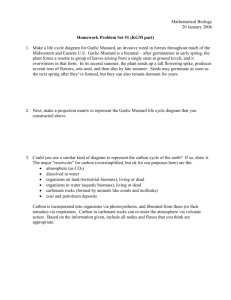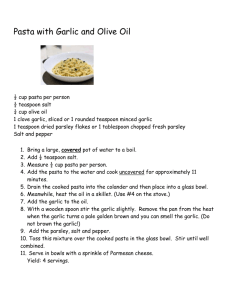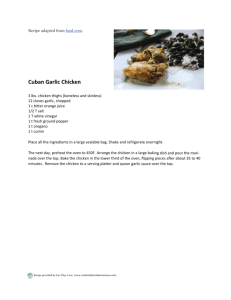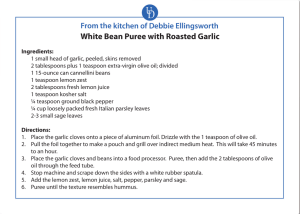Garlic Production for the Gardener
advertisement
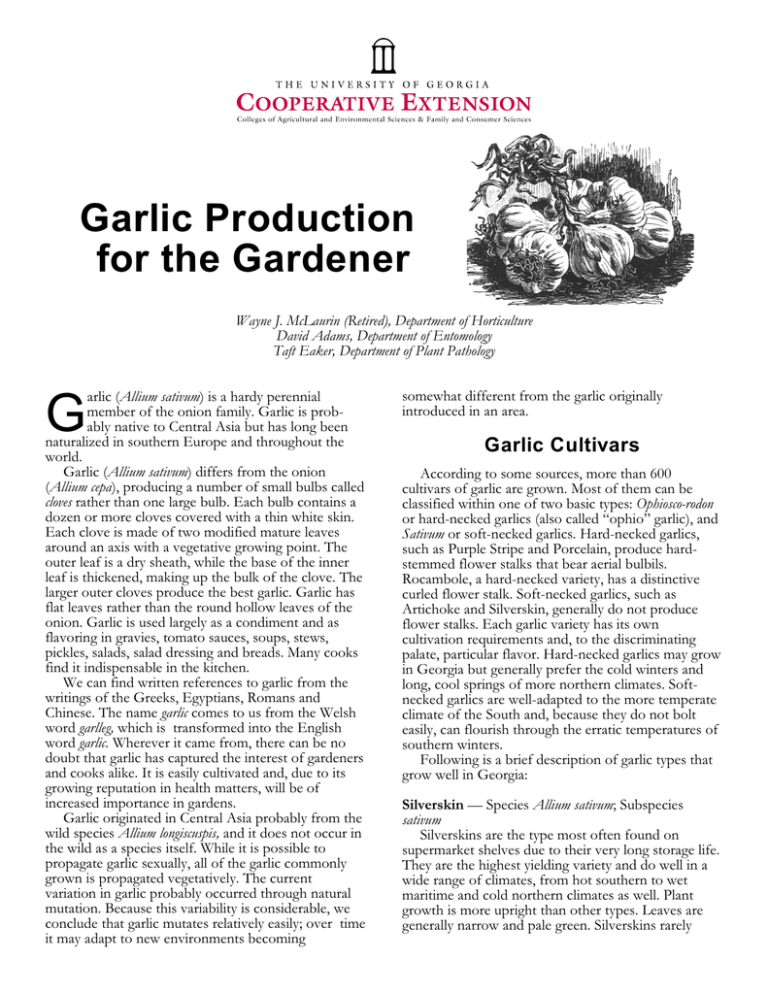
Garlic Production for the Gardener Wayne J. McLaurin (Retired), Department of Horticulture David Adams, Department of Entomology Taft Eaker, Department of Plant Pathology arlic (Allium sativum) is a hardy perennial member of the onion family. Garlic is probably native to Central Asia but has long been naturalized in southern Europe and throughout the world. Garlic (Allium sativum) differs from the onion (Allium cepa), producing a number of small bulbs called cloves rather than one large bulb. Each bulb contains a dozen or more cloves covered with a thin white skin. Each clove is made of two modified mature leaves around an axis with a vegetative growing point. The outer leaf is a dry sheath, while the base of the inner leaf is thickened, making up the bulk of the clove. The larger outer cloves produce the best garlic. Garlic has flat leaves rather than the round hollow leaves of the onion. Garlic is used largely as a condiment and as flavoring in gravies, tomato sauces, soups, stews, pickles, salads, salad dressing and breads. Many cooks find it indispensable in the kitchen. We can find written references to garlic from the writings of the Greeks, Egyptians, Romans and Chinese. The name garlic comes to us from the Welsh word garlleg, which is transformed into the English word garlic. Wherever it came from, there can be no doubt that garlic has captured the interest of gardeners and cooks alike. It is easily cultivated and, due to its growing reputation in health matters, will be of increased importance in gardens. Garlic originated in Central Asia probably from the wild species Allium longiscuspis, and it does not occur in the wild as a species itself. While it is possible to propagate garlic sexually, all of the garlic commonly grown is propagated vegetatively. The current variation in garlic probably occurred through natural mutation. Because this variability is considerable, we conclude that garlic mutates relatively easily; over time it may adapt to new environments becoming G somewhat different from the garlic originally introduced in an area. Garlic Cultivars According to some sources, more than 600 cultivars of garlic are grown. Most of them can be classified within one of two basic types: Ophiosco-rodon or hard-necked garlics (also called “ophio” garlic), and Sativum or soft-necked garlics. Hard-necked garlics, such as Purple Stripe and Porcelain, produce hardstemmed flower stalks that bear aerial bulbils. Rocambole, a hard-necked variety, has a distinctive curled flower stalk. Soft-necked garlics, such as Artichoke and Silverskin, generally do not produce flower stalks. Each garlic variety has its own cultivation requirements and, to the discriminating palate, particular flavor. Hard-necked garlics may grow in Georgia but generally prefer the cold winters and long, cool springs of more northern climates. Softnecked garlics are well-adapted to the more temperate climate of the South and, because they do not bolt easily, can flourish through the erratic temperatures of southern winters. Following is a brief description of garlic types that grow well in Georgia: Silverskin — Species Allium sativum; Subspecies sativum Silverskins are the type most often found on supermarket shelves due to their very long storage life. They are the highest yielding variety and do well in a wide range of climates, from hot southern to wet maritime and cold northern climates as well. Plant growth is more upright than other types. Leaves are generally narrow and pale green. Silverskins rarely produce flower stalks in mild climates, but may when stressed by cold winters or drought conditions. Bulb wrappers are fine and smooth, usually all white. Three to six clove layers are common. Total cloves per bulb vary from 12 to 20. Outer cloves are usually flat and wide, while inner cloves are tall, narrow, and concave. Silverskins have long been the most popular type for garlic braids because of the smooth, shiny skin, symmetrical shape, and easily manipulated tops. Silverskins are the last to be harvested and may lodge (fall over) a week or more before harvest due to their weak necks. Elephant garlic (Allium ampeloprasum) is not a true garlic but a type of leek that produces very large cloves, often only three or four per bulb. Several small bulblets may also develop. It produces a large seedstalk that may be cut and used for ornamental purposes. The more tender, fleshy lower portion of the seedstalk is also prized as a stir-fried vegetable. Flavor is milder than garlic and can be slightly bitter. Elephant garlic grows under the same conditions as regular garlic. Below is a suggested list of varieties you may wish to consider. Artichoke (Softneck): Inchelium Red: 4-5 clove layers with 8-22 cloves; bulbs more than 3 inches in diameter possible; mild lingering flavor. California Early: 4 clove layers with 10-22 cloves; clove color tan to off white with pinkish blush; mild, slightly sweet flavor. Chet’s Italian: 4 clove layers with 10-20 cloves; clove skins milk white or yellowish; mild flavor; severe cold gives it a stronger taste. Silverskin (Softneck): Mild French: 4 clove layers with 13-16 cloves; clove color varies from reddish-pink blush on yellow-white background to pink-brown; better adapted to hot dry climates; sharp taste when raw but simple, smooth, nutty taste when cooked. Silverskin: 15-20 cloves per bulb usually in 5 layers; clove color off white to tan with pink blush; good producer of large bulbs; mild and sweet taste at first but can be hot. Artichoke — Species Allium sativum, Subspecies sativum Artichoke strains are very vigorous and largebulbed. Plants are shorter than hard-neck varieties with spreading rather than upright leaves. The leaves are broader than any other variety and a deeper green than most. While Artichokes do not normally produce a seed head, they often produce large bulbils that protrude from the lower third of the stem. When stressed, Artichokes can produce hard necks and seed heads. Cloves planted from these bulbs will usually revert to soft necks the following season. Artichokes are named for their configurations of several overlapping layers of cloves, reminiscent of the true artichoke. Many artichoke strains have 3-5 clove layers containing 12 to 20 total cloves. Outer cloves are fat and roundish but irregular in shape, often with 3 flat sides and a paper-like tail at the tip. Inner cloves vary in shape from small, narrow, and squarish to small and round. Bulb wrappers are coarse and thick, often with light purple blotches or a yellow stain. Some artichoke strains produce large round, symmetrical bulbs, while others have a knobby, asymmetrical appearance. Clove skins adhere fairly tightly, one reason for Artichokes’ longer storage life. Many Artichokes have a mild flavor, a characteristic preferred by those who eat their garlic raw for health reasons. A few strains, however, do produce a bite that can be intensified by cold winter growing conditions. Garlic Culture Garlic is easy to grow in the garden. Late September through November is the time to plant garlic in Georgia. The plant is extremely frost hardy and, if planted in October, may have tops showing above the soil and be well rooted by November. The crop matures in the early summer. The growing period is too short for satisfactory yields if planted in the spring since bulbing and maturity will not take place when temperatures are high. The reason that garlic is planted in the fall in Georgia is to permit full leaf development. As soon as bulbing starts, leaf initiation ceases. For highest yields, therefore, the cloves must be planted early enough to permit the development of large vegetative plants during the short, cool days of late winter. The yield potential of the plants depends on the amount of vegetative growth before bulbing commences. Bulb growth and development in the garlic plant is favored by long days and warm temperatures. 2 may be uneven. As the temperature warms, leaf development will accelerate with flat, dark green leaves on stems reaching a height of 1 foot or more. Keep plants well watered during this growth period. Although vernalized (vernalization -- subjected to sufficient cold in order to induce bulbing), no inflorescence or lateral buds (that later form the bulb) are developed until early spring with the onset of lengthening days and suitable tempera-tures. Proper bulbing is a function of adequate growth, vernalization, and subsequent growth under longer days. As temperatures rise and day length increases, bulb formation begins. Do not apply any more fertilizer after bulb formation begins (see fertility). In June to early July, leaves will begin to turn brown and tops will fall, indicating maturity. Stop irrigation at this time to avoid bulb discoloration and bulb rots. To ensure bulbs are fully mature, remove the top layer of soil over the top of a few bulbs and check bulbs to make sure they are fully differentiated (division of bulb into distinct cloves). Digging bulbs prematurely can cause spoilage during storage, while waiting too long can cause disease and/or discoloration on the bulbs. Crop Rotation and Location It is a good idea to practice rotation when planting garlic. Don’t plant garlic where onions or a member of the onion family has been grown previously. Plant garlic in full sun and in a well-drained bed with organic matter worked into it. Garlic likes well-drained soil, and the addition of organic matter will help even the hardest clay become more friable. Also, since garlic requires up to 8 months to mature, plant in an area where it won’t be disturbed. Planting Garlic does not produce true seed but is propagated by planting cloves, which are the small bulblets or segments making up the garlic bulb. Each bulb usually contains a dozen or more cloves; each clove is planted separately. Select only larger outer cloves of the best garlic bulbs for planting. The larger cloves yield larger size, mature bulbs at harvest. Do not divide the bulb until ready to plant; early separation decreases yields. Select “seed bulbs” that are large, smooth, fresh, and free from disease. To plant garlic properly, dig a hole or trench, place the unpeeled clove gently into the hole with the pointed side up (the scar [stem] end down) and cover the clove with soil. Setting the cloves in an upright position ensures a straight neck. Approximately 2-3 pounds of garlic bulbs will plant 100 feet of row. The amount will vary depending on variety (number of cloves per pound), row width, and plant spacing. Plant cloves 1-3" deep and 6" apart. Rows are usually planted 12-14" apart. In colder areas of the state, cloves may be planted slightly deeper for winter protection. Mulching will help protect bulbs from severe cold and will help conserve moisture. Irrigate immediately after planting. Irrigation Garlic requires an even, consistent supply of water. However, too much will cause “wet-feet” and may cause bulb rots to occur. Garlic is planted in Georgia at one of the driest times of the year. Thorough watering at planting time is needed to establish the planting. In spring, keep garlic growing actively. According to the rainfall, garlic may need extra moisture in spring and early summer. Research in California has shown that water stress during clove development has been implicated in witches-brooming and small cloves. Do not irrigate garlic once the tops begin to fall and become dry. April and May is a critical period for diseases. Exercise care in disease control and irrigation. Water early in the day so garlic can be dry by nightfall, thereby reducing the chance of disease. Soil type does not affect the amount of total water needed but does dictate frequency of water application. Lighter soils such as those in south Georgia need more frequent water applications but less water applied per application. The heavier soils of north Georgia need fewer applications but more water per application. The same general rule applies to garlic as to other garden plants — 1 inch per week of water with good drainage. Plant Development Matured garlic cloves planted in the fall go through a dormant period. Garlic cloves requires a period of 6-8 weeks of cool weather after planting (below 40 degrees F) to undergo vernalization (inducement to bulb and flower) by low winter temperatures. With adequate moisture and lower temperature, roots emerge and leaves sprout, and the plant goes through a period of vegetative growth. During the fall and winter in Georgia, cloves will develop their root systems and initiate some top growth. The clove will swell considerably, forming a globular bulb with many fine roots. A pair of intertwined leaves will emerge from the terminal end of the bulb and will eventually break through the soil, depending on the weather and location. Emergence 3 Calcium, magnesium and sulfur — Calcium and magnesium may be low in acid soils. The need for these elements usually can be met by using dolomitic lime and following lime recommendations. Sulfur is a major constituent of compounds believed to be involved with the medicinal qualities of garlic. Adding sulfur does not appear to increase yield, but there is active interest in determining how sulfur fertilizers may affect garlic flavor and medicinal compounds. Micronutrients — Addition of compost or other types of organic amendments will help to ensure that micronutrient supplies are adequate. Most areas of Georgia, with the exception of the coastal plain, have adequate amounts of micronutrients available for plant growth. Soil Requirements Garlic grows best in full sun and a well drained soil. Also, garlic grows best on friable (crumbly), loamy soils that are fertile and have some organic matter. The soil must be kept evenly moist as dry soil will cause irregularly shaped bulbs. Heavy clay soils will also create misshaped bulbs and make harvesting difficult. Add organic matter, such as well-rotted manure or compost, to the soil on a yearly basis to keep it friable. Garlic bulbs will be small if the soil is excessively dry and irregular in shape if the soil becomes compacted. Soil Fertility Prior to planting, soils should be well tilled to provide a loose soil bed for bulb growth. Garlic grows best on well-drained soils with added organic matter. Sandy loam or loam soils have the most ideal texture for growing garlic. However, with the addition of organic matter, clay soils will produce garlic quite well. Also, a green manure crop tilled in a few weeks before planting is recommended to improve soil physical properties. Well-composted manure applied and incorporated at a rate of 100 lbs. per 100 sq. ft. is ideal as a soil amendment, especially on low organic matter soils. Drought or excessively wet conditions will reduce bulb yields. The optimum soil pH for garlic is between 6 and 7. Liming is recommended if the pH is less than 5.8. Garlic grows well with medium to high amounts of fertilizer. As a general recommendation, apply three pounds of 10-10-10 fertilizer per 100 square feet. Follow soil test recommendations for your particular garden soil. Nitrogen — Garlic has a medium to high demand for nitrogen. About one-quarter to one- third of the recommended N should be broadcast and incorporated in early fall before planting; use 5-10-15 or 10-10-10 or an organic source such as blood meal. The remainder of the N should be top-dressed in the spring after shoots are 4 inches to 6 inches tall. In late February or early March, sidedress garlic with about 1 pound of ammonium nitrate per 100 feet of row. Avoid N applications after the first week in April to prevent delayed bulbing. Be sure to figure in the nutrient value of applied amendments such as manure or compost. Symptoms of nitrogen deficiency include a yel-lowing of older leaves and leaf tips, general yellowing of the plant, poor vigor and low yields. Phosphorus and potassium — Take soil tests before planting to determine phosphorus and potassium needs. Incorporate all P and K fertilizers before planting. Symptoms of P deficiency include dark green to purple leaves and stunted growth. Symptoms of K deficiency include marginal scorching of the older leaves. Pests of Garlic Diseases Garlic is susceptible to most onion diseases, including botrytis, pink root, powdery mildew and purple blotch. Bulb rot can also be a problem in poorly drained soils. Good sanitation and long- term crop rotation is important to overcome these problems. Insects The onion thrip can be a major problem on garlic. Garlic gardeners should also scout for damage from cutworms, cabbage loopers and wireworms. In certain areas of Georgia, onion root maggots may be a problem. Check with your local county agent for appropriate control measures. W eeds Weed control is essential for proper development of garlic plants. Garlic has a very shallow root system. Like onions, it does not compete with weeds very well. Cultivation, hand picking and hoeing are the only viable alternatives for weed control. Cultivation should be very shallow to prevent root damage. Mulch is another viable weed control option. Apply mulch after garlic has emerged. Prior to emergence, weed control should be by hand. Use 2-3" of mulch over the entire area. Keep mulch 2-3" away from the plant stem. As with any other plant, mulch might create an environment for disease if it contacts the stem and is kept too damp. Harvest Depending on the area of Georgia you live in, garlic will be ready to harvest from late May to mid July as the tops begin to dry and turn yellow. When garlic is mature, leaf tops will begin to dry, discolor and bend towards the ground. Harvest the garlic when 1/3 to 1/2 4 of the leaves have died back in this manner. Use a fork to loosen the soil and facilitate lifting the bulbs, thus avoiding stem injury. This is especially important if you plan to braid the tops. If harvesting is delayed too long after the tops have died back, the bulbs may rot. Allow healthy, harvested bulbs to dry in the sun for several days. It is a good idea to cover the bulbs with the tops to prevent direct sunlight striking them. When the tops and bulbs are dry, especially at the neck area, you can cut the leaves off and store in a cool dry place. Approximate yield/10 feet of row is 4 lbs. With normal production, a home garden can yield a year’s supply for the average family. Storage The key to keeping your garlic fresh is to keep it in an dark environment where the temperature does not fluctuate radically and the garlic has adequate air circulation. Any cool, well-ventilated place will do for storage through the winter months. In very cold areas, the bulbs should be protected from freezing. A mesh bag full of garlic kept in a little-used cupboard or cold cellar is an ideal situation. Humidity should be around 70 percent. When you are removing garlic for use, be sure that the remaining bulbs are not exposed to light as this will trip the bulb into growth, thereby lessening the length of time it will stay fresh. Also, radical changes in temperature may also cause the bulb to sprout. Storing whole bulbs of garlic in the refrigerator is not recommended. However, you can store some garlic in the refrigerator. Break apart the bulb, peel each clove and then store them in a covered container (small glass containers work well). The cloves will stay firm for several weeks and you have a convenient supply of prepared cloves ready for use when you need them. Always save the largest and best-formed bulbs for planting. 1 3 2 4 Garlic Braiding so the heads are clustered next to each other (2).Lay the fourth bulb on top of the braided stalks just below the cluster of the first three bulbs. Place the stalk of the fourth bulb with the stalk that’s in the center of the braid and bring the far right stalk from the bottom up and over all the other stalks. Take the stalk on the left and bring it up and over all the other stalks (3). Now lay another bulb below the cluster of bulbs, letting its stalk rest with the center group of stalks. Bring the right section of stalks up and over. Continue to build the braid, adding one head at a time, and always bring the stalks up from the bottom (4). Like all braids, you’ll have three stems, or sections, of stalks at any one time – it’s much like Frenchbraided hair. By the time you add your last head or two of garlic, the braided stalks will be quite thick. When the last head has been added, continue braiding the three streams of stalks, incorporating a few sprigs of dried herbs, if desired, until you have about 4 or 5 inches of braid below the last bulb (4). Tie off the end of the braid with jute or raffia (4). Hang to dry in a cool, dark area out of the light. Garlic Braiding A coil of braided garlic is decorative as well as useful. Just remember the rules for storing still apply: Hang it away from heat and light. The ideal time to braid is when the garlic stems are half brown but still pliable – fresh garlic may develop mold because of poor air circulation around the bulbs in the braid. Soft-neck types are usually easier to work with because their stalks aren’t as stiff and thick as hard-neck varieties. You’ll need about 8 to 10 heads, natural jute or raffia (not string, which may contain creosote) to tie off the finished braid, and a flat surface to work on. Start with three bulbs on a flat surface with the stalks facing you (See illustration at right, 1). Braid the three stalks together once or twice, pulling on the talks 5 Girardin Gourmet Gardens 29321 Enger Court Cannon Falls, MN 55009 507-263-5897 References Aaron, C. 1997. The Great Garlic Book: A Guide with Recipes. Berkley, California: Ten Speed Press. Irish Eyes with a Hint of Garlic (formerly Ronnigers) PO Box 307 Ellensburg, WA 98926 http://www.irish-eyes.com/potatoes@irish-eyes.com Behnke, Charles T. 1992. Growing Garlic in the Home Garden. Ohio State University Extension Fact Sheet HYG-1627-92 Brewster, J.L. and H.D. Rabinowitch. 1990. Onions and Allied Crops, Volume 3, Biochemistry, Food Science and Minor Crops. Boca Raton, Florida: CRC Press. Johnny’s Selected Seeds Foss Hill Rd. Albion, ME 04910-9731 (207) 437-4301 www.johnnyseeds.com Engeland, R.L. 1991. Growing Great Garlic: the definitive guide for organic gardeners and small gardeners. Okanogan, Washington: Filaree Productions. Nichol's Garden Nursery 1190 N. Pacific Highway Albany, OR 97321-4598 (503) 928-9280 http://www.nicholsgardennursery.com/ Gough, Robert E. 1999. Growing Garlic in Mon-tana. Montana State University Extension Service C-7 (Vegetables) Gourmet Garlic Gardens – A Garlic Information Center. http://www.gourmetgarlicgardens.com/ Peaceful Valley Farm Supply PO Box 2209 Grass Valley, CA 95945 (530) 272-4769, (888) 784-1722 www.groworganic.com contact@groworganic.com Jones, Henry A. and Louis K. Mann. 1963. Onions and Their Allies, Botany, Cultivation, and Utilization. New York, New York: Inter-science Publishers, Inc. Rosen, Carl, Roger Becker, Vince Fritz, Cindy Tong, Bill Hutchison, Jim Percich, Jerry Wright. 1999. Growing Garlic in Minnesota. University of Minnesota Cooperative Extension Service publication 7317. http://www.extension.umn.edu/ distribution/cropsystems/DC7317.html Seed Savers Exchange RR 3, Box 239 Decorah, Iowa 52101 319-382-5872 http://www.seedsavers.org/ Stephens, James M. 1994. Garlic Fact Sheet HS-597, Florida Cooperative Extension Service, Institute of Food and Agricultural Sciences, University of Florida. http://edis.ifas.ufl.edu/ MV064 Silver Springs Nursery HRC 62 Box 86 Moyle Springs, ID 83845 208-267-5753 Territorial Seed Company P.O. Box 157 Cottage Grove, OR 97424 541-942-9547 http://www.territorial-seed.com/ E-mail: tertrl@srv1.vsite.com Sources for Garlic Seed Arnold Farm Rt. 2, Box 36 Long Prairie, MN 56347 320-732-4398 Weavers Garlic Shedd P.O. Box 67 Crabtree, OR 97335 541-491-3840 Filaree Farm 182 Conconully Hwy Okanogan, WA 98840 509-422-6940 http://www.filareefarm.com/ email:filaree@northcascades.net 6 The illustration at the beginning of this publication is from The Vegetable Garden Illustrations, Descriptions, and Culture of the Garden Vegetables of Cold and Temperate Climates by M.M. Vilmorin-Andrieux, Paris. English edition published under the direction of W . Robinson. Published by John Murray, Albemarle Street, London. 1905. 7 The University of Georgia and Ft. Valley State University, the U.S. Department of Agriculture and counties of the state cooperating. Cooperative Extension, the University of Georgia College of Agricultural and Environmental Sciences, offers educational programs, assistance and materials to all people without regard to race, color, national origin, age, gender or disability. An Equal Opportunity Employer/Affirmative Action Organization Committed to a Diverse Work Force Circular 854 Reviewed April, 2009
